Water for a thirsty city
By Simon Miller, Library Technician, State Library of Queensland | 13 May 2014
I was interested to read an article recently revealing that Brisbane based company Underground Opera has reached agreement with the Brisbane City Council to stage a series of performances in the Spring Hill Reservoirs. These underground reservoirs, the first built in 1871, were still in use until 1962. Most Brisbane residents, myself included, have not known of the existence of these rather striking vaulted brick spaces, whose only visible sign is a couple of modest low roofed structures on the hillside below the iconic Windmill. What is the story of these reservoirs, and how do they fit in to the vital story of supplying water to a rapidly growing city?
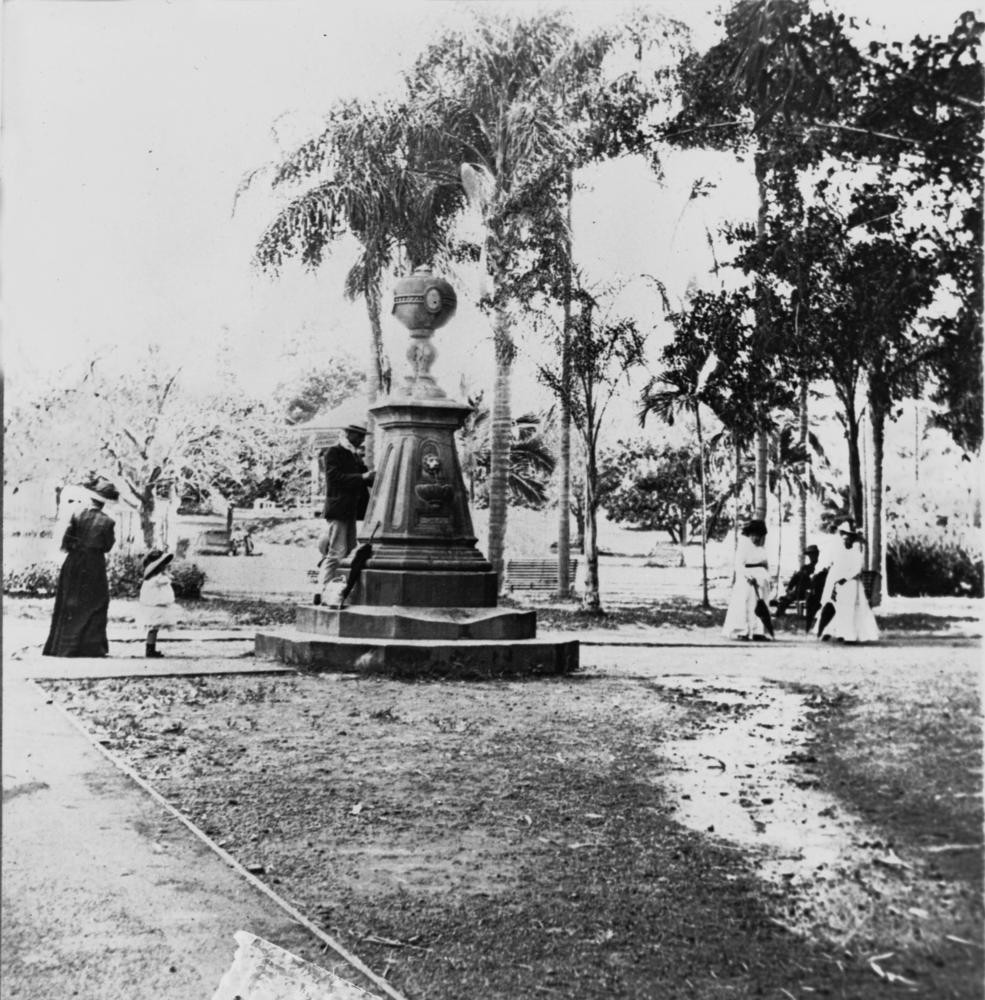
Drinking fountain in the Botanic Gardens in Brisbane, ca. 1910, John Oxley Library, State Library of Queensland Neg: 24215
The first Moreton Bay settlement was established at Redcliffe but the water supply soon dried up and the settlement was relocated to Brisbane where there was a reliable water source. This was a creek that emerged at Yorks Hollow near the current location of Brisbane Grammar School and flowed through what would be the middle of the city, entering the Brisbane River near Creek Street. This creek was augmented by an earth dam in 1838 under the direction of Captain Logan and this reservoir served as the cities only public water supply, with some improvements, until 1866. The Brisbane River itself is too salty for drinking, being subject to tidal flows for a considerable distance past the city.
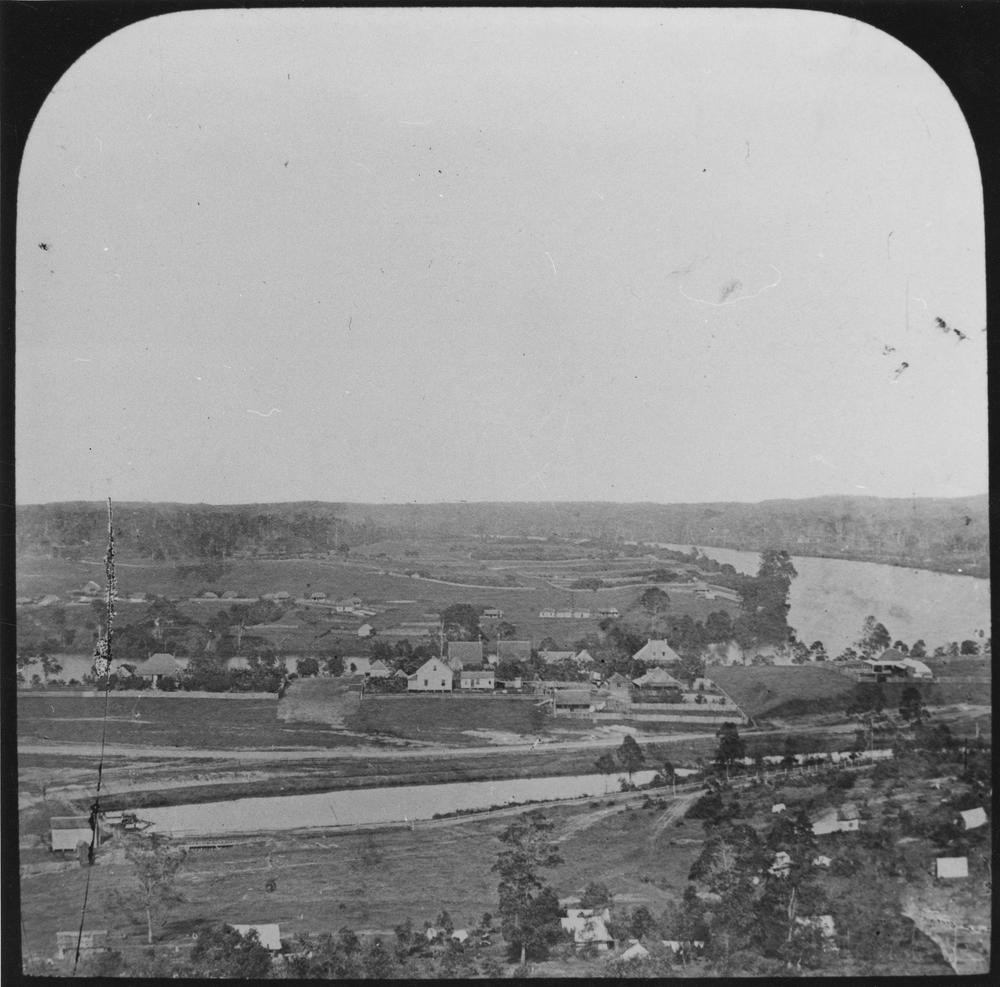
Roma Street Reservoir ca. 1862. John Oxley Library, State Library of Queensland Neg:147714
The Reservoir was the subject of many complaints in the newspapers. This editorial from the Moreton Bay Courier of 23 March 1850 criticizes the neglect of the provision of fresh water if favour of less vital projects and goes on to a damning assessment of the state of the Brisbane Reservoir. (racist language warning)
These remarks, which are more or less applicable to the whole colony, apply with peculiar force to the towns, and in particular to the town of Brisbane, for there, from the probable future centralization of population, the uncertainty of the seasons, and the absence of fresh water streams, a scarcity of water may be anticipated as a natural contingency if not provided against, and would be most severely and fatally felt. We need only point to the neglected condition of the public reservoir at North Brisbane, upon which that section of the town is chiefly dependant for its supply, to prove the utter indifference hitherto displayed in this respect. Constructed for the purpose of collecting and preserving the waters that drain from the hills in the vicinity; reserved from sale as a public property for that purpose, the reservoir is still abandoned to the destructive ravages of wanton neglect. Its embankments are gradually being washed away, and the water that should be saved for a time of need is allowed to drain off whithersoever chance may guide it. The basin is open alike to the uses of herds of cattle, of stray pigs, dogs, and horses, and to the filthy ablutions of greasy blackfellows. It needs no long sight to predict the speedy annihilation of this source of supply, at the present rate. It is a fact that in proportion to the increase of population in Brisbane, the means of supplying the town with freshwater has been growing indifferent. So long as a cask of water can be obtained at the usual price, no person looks forward, but the spendthrift motto seems to be adopted, to live while you can, and die when you must."
In 1863 the first Queensland Parliament turned its attention to the water supply and passed a bill to enable the Municipal Council of Brisbane to construct waterworks and to lay down pipes, or to erect public fountains and wells, and to charge for such service. The Council raised a loan of £50,000 from the Treasury and prepared preliminary plans for a water supply at Enoggera Creek. On 18th August, 1864, the first sod was turned by Mr A. C. Gregory, the Surveyor-General and works were completed in August 1866. Just as the work was nearing completion the State Government took control away from the Municipal Council and appointed the Brisbane Board of Waterworks to run the service.
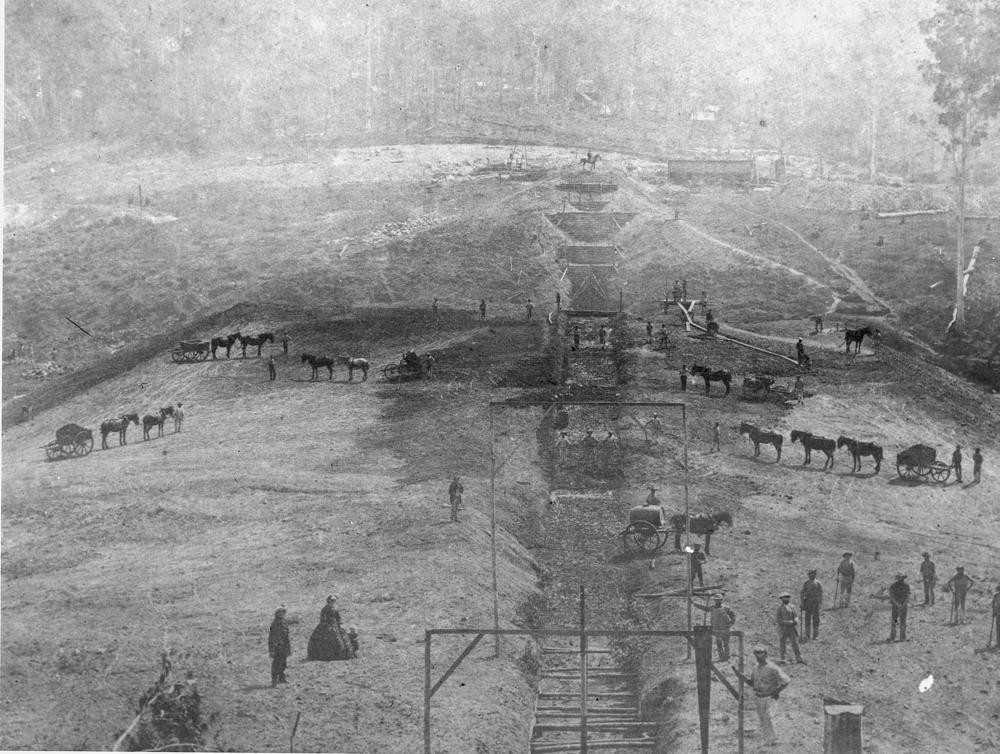
Workers constructing the Enoggera Reservoir, Brisbane, ca. 1864, John Oxley Library, State Library of Queensland Neg: 103336
Some additional pipes were laid in 1869 making a pipe service of some 11 miles within the city boundaries serving up to 6,000 people. The first service reservoir, the underground brick structure soon to echo with music, was constructed in 1871. The service reservoirs received water from the main supply from Enoggera. The water was then distributed from the service reservoir, ensuring no interruption due to excess demand. As the population of the city continued to grow there was need to increase the supply of water and a new dam was constructed at Gold Creek, completed in 1885.
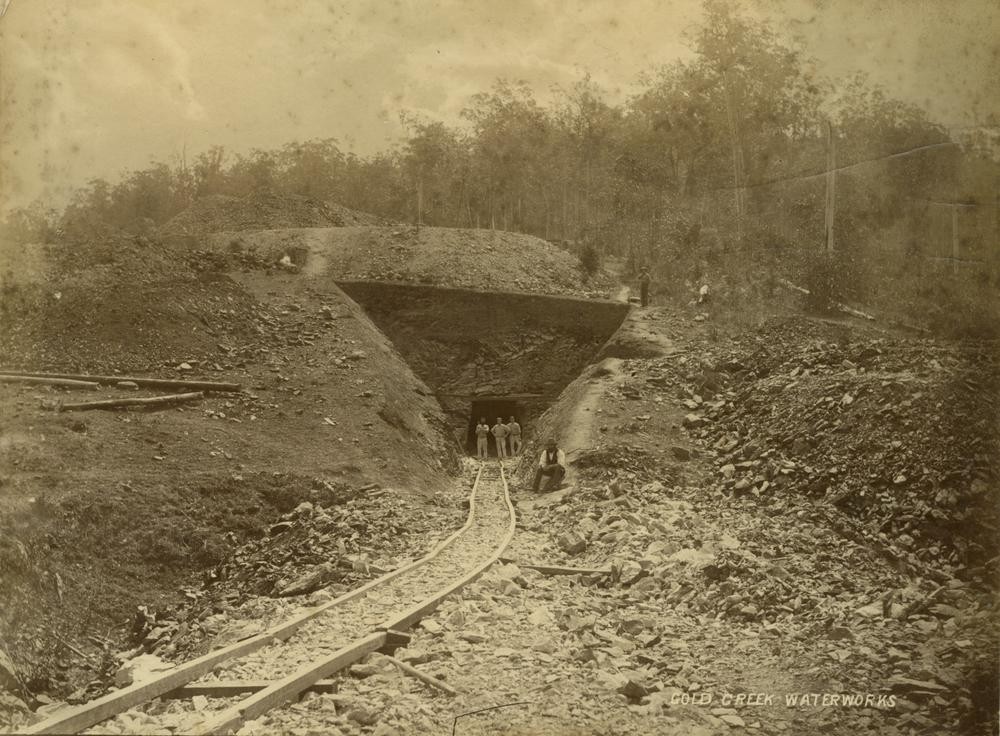
Workers standing at the entrance to the tunnel at Gold Creek Waterworks, Brisbane, ca. 1885, John Oxley Library, State Library of Queensland Image number: APO-014-0001-0016
The construction of the Gold Creek Dam allowed for improvements to be made to the water supply for South Brisbane and a service reservoir was constructed on Highgate Hill supplied by a branch from the mains coming from Gold Creek and passing under the Brisbane river. The Brisbane Courier of 10 October 1889 provides this description of the construction of the reservoir.
A more detailed description of the reservoir may now be entered upon. It has been constructed on the highest part of the hill, on property purchased from Mr. Skinner, and formerly occupied by the residence of Judge Sheppard. The reservoir is a large tank excavated in the rock, lined with concrete, and divided into four equal compartments. It is 207ft. in length by152 ft. wide, and the depth of water, when full, is 12ft. 3in. The walls are 7ft. in thickness where the greatest strain has to be met, tapering to 3ft. at the top, whilst in other parts it begins at 3ft. 6in. and runs out to 18in. The sides rise but a few inches above the surrounding surface, and the whole is protected by a roof composed of matched boards covered with galvanised iron, with felt between the iron and timber to keep out the heat. The roof is supported on four sets of arched iron principals, which rest on the walls of the reservoir and on two rows of iron columns running from end to end. The dust and heat are thus excluded, and evaporation is prevented
Similar reservoirs can now be found on high points around the city.
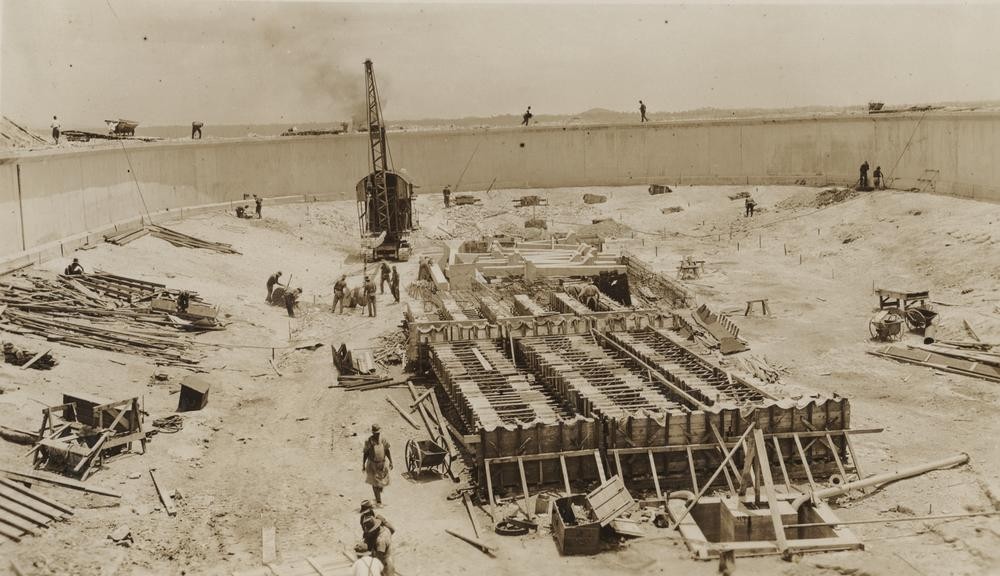
Reservoir construction in Albion, ca. 1929, John Oxley Library, State Library of Queensland Image number: 10189-0002-0058
Soon after the Highgate Hill reservoir was completed the Board arranged for construction of an improved pumping station and a storage reservoir at Mount Crosby, on the Brisbane River. This work was completed in 1892 and the Mount Crosby reservoir was Brisbane's main water source at the time of publication of Brisbane's Water Supply, issued by the Brisbane Board of Waterworks, in 1909. The Board was very proud of their acheivements.
Great have been the transformations of the past, but to-day, as never before, the march of progress is manifest. The pressure of population and the demand for greater efficiency than was accepted yesterday are two factors that compel attention. They ask not quietly and respectfully as in days of old ; they demand loudly and sternly. But great though future transformations may be, they will never shame the progress of the past, but serve rather to show how carefully the foundations of the great scheme were laid, and how generously the requirements of a growing city have been met.
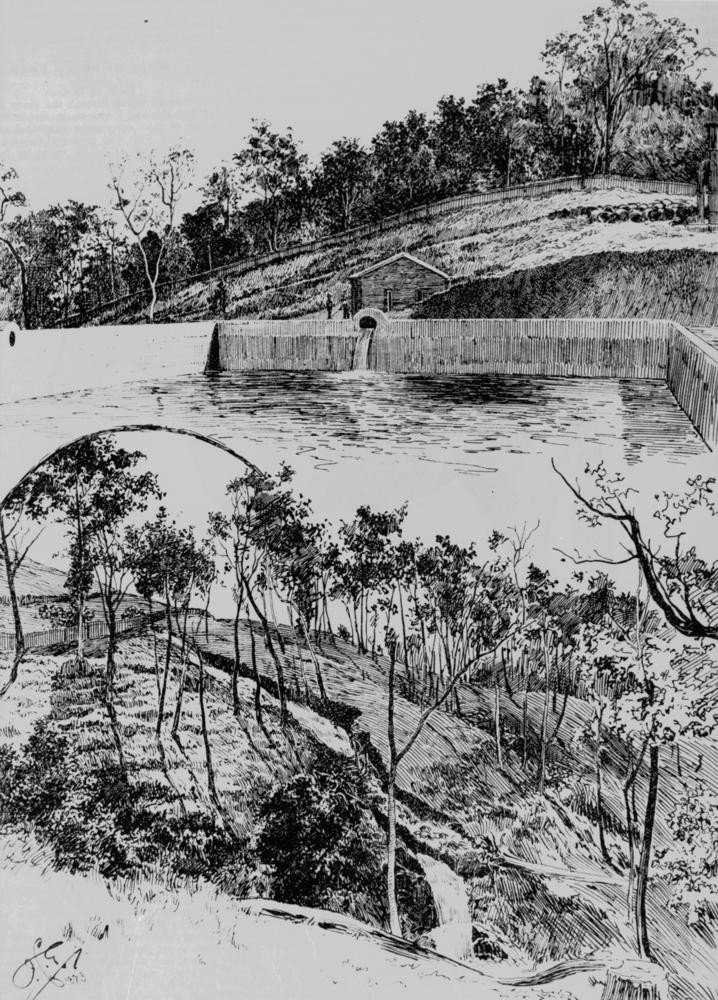
Sketch of the reservoir at Mount Crosby, 1893, John Oxley Library, State Library of Queensland Neg: 193086
Since 1909, of course, Brisbane's population has continued to grow rapidly and new sources of water have had to be found. In 1916 Lake Manchester Dam was completed North-West of Mt Crosby. In 1935 work commenced on Somerset Dam and after an interruption due to material shortages during World War Two it was eventually completed in 1959. North Pine Dam was completed in 1976, holding 200,000 megalitres of water and Wivenhoe Dam was finished in 1985 at a cost of $160 million, with a storage capacity of 1.15 million megalitres.
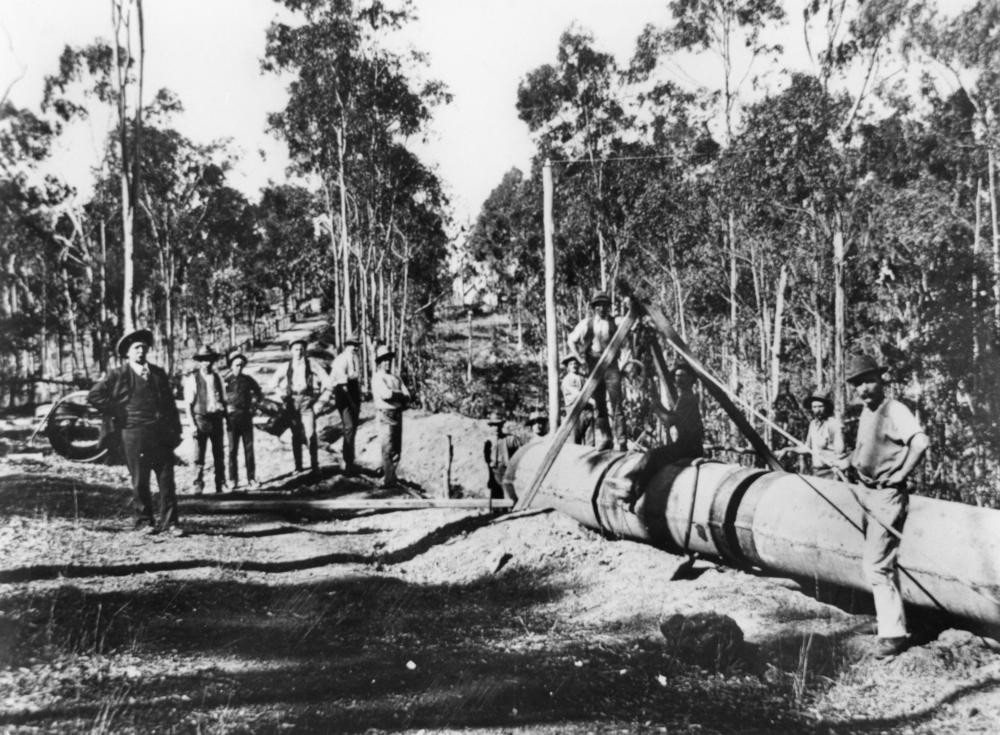
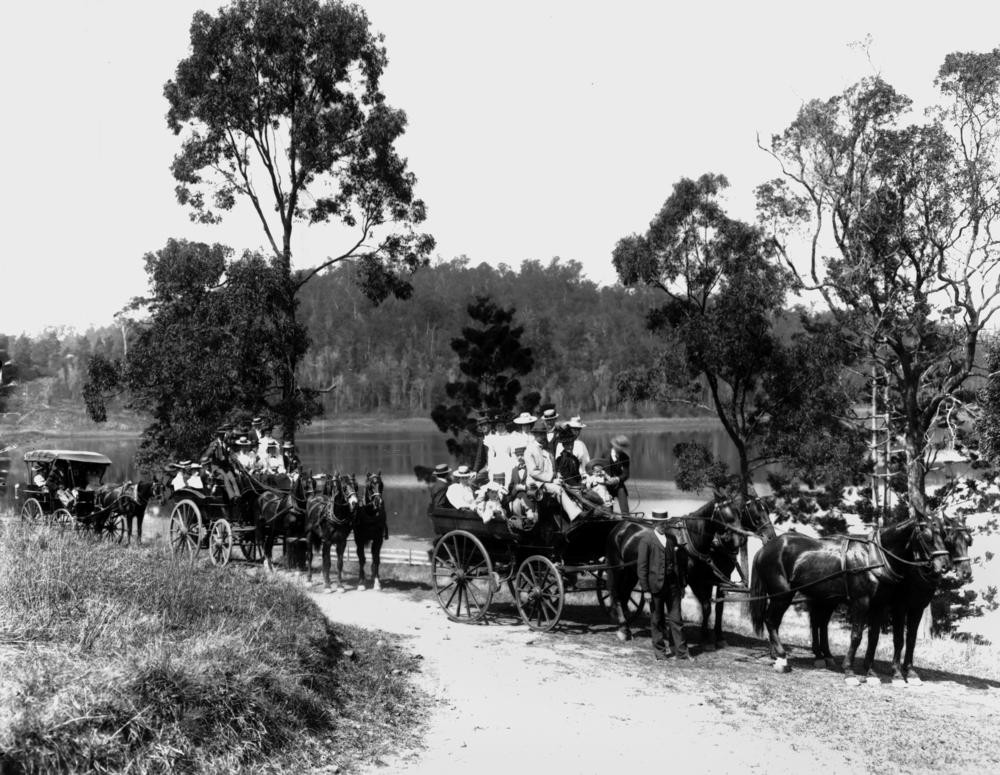
Day trippers travelling to Enoggera Reservoir, Brisbane, ca. 1896, John Oxley Library, State Library of Queensland Neg: 123081
Not sure where these places are? All the illustrations in this article have been pinned to the map in Historypin on our State Library of Queensland channel.
Simon Miller - Library Technician, State Library of Queensland
Comments
Your email address will not be published.
We welcome relevant, respectful comments.